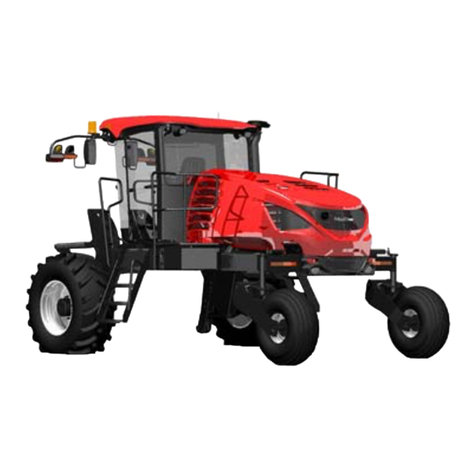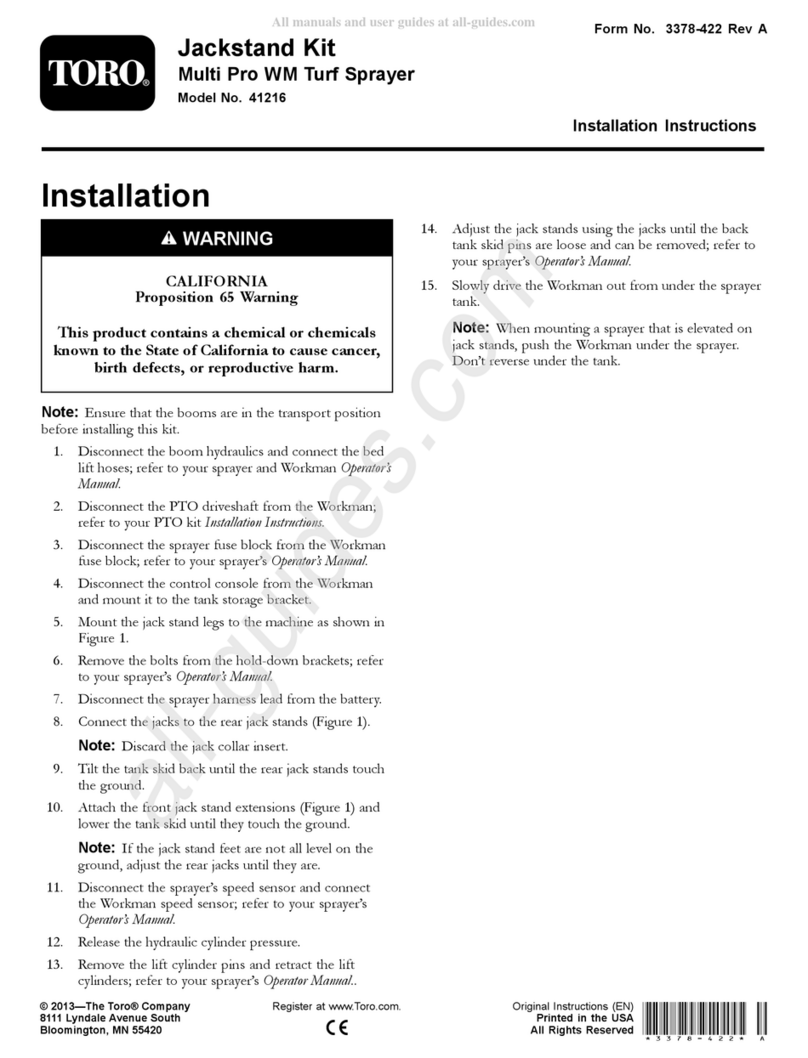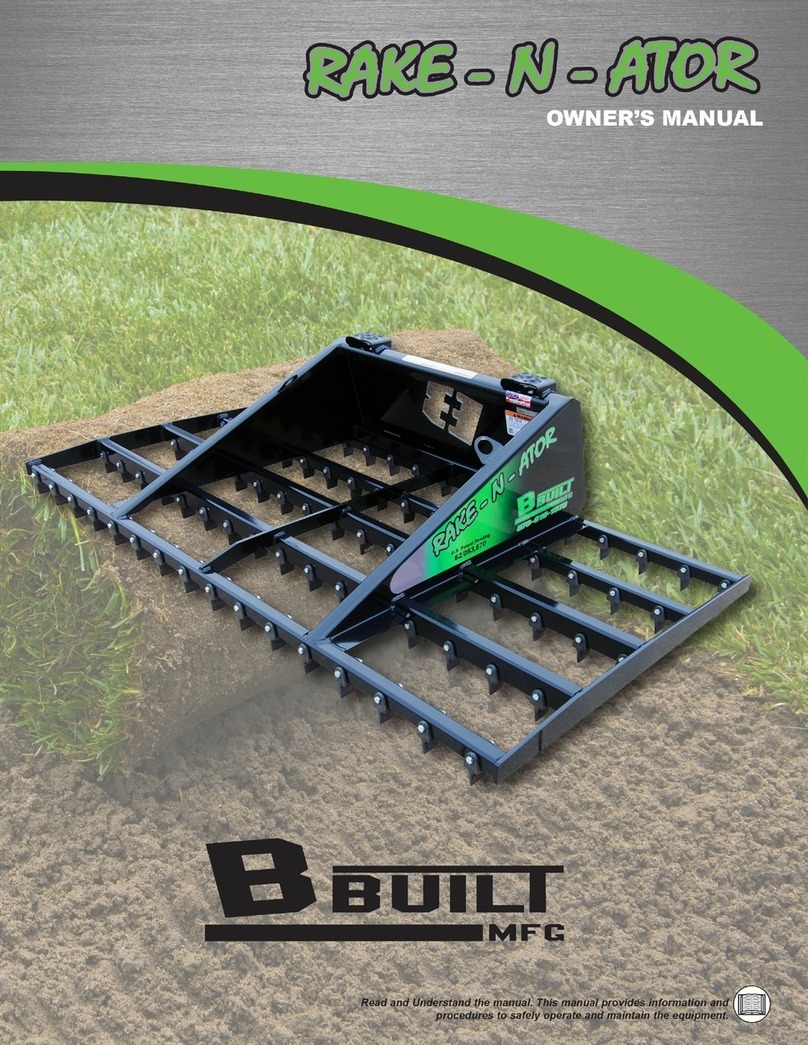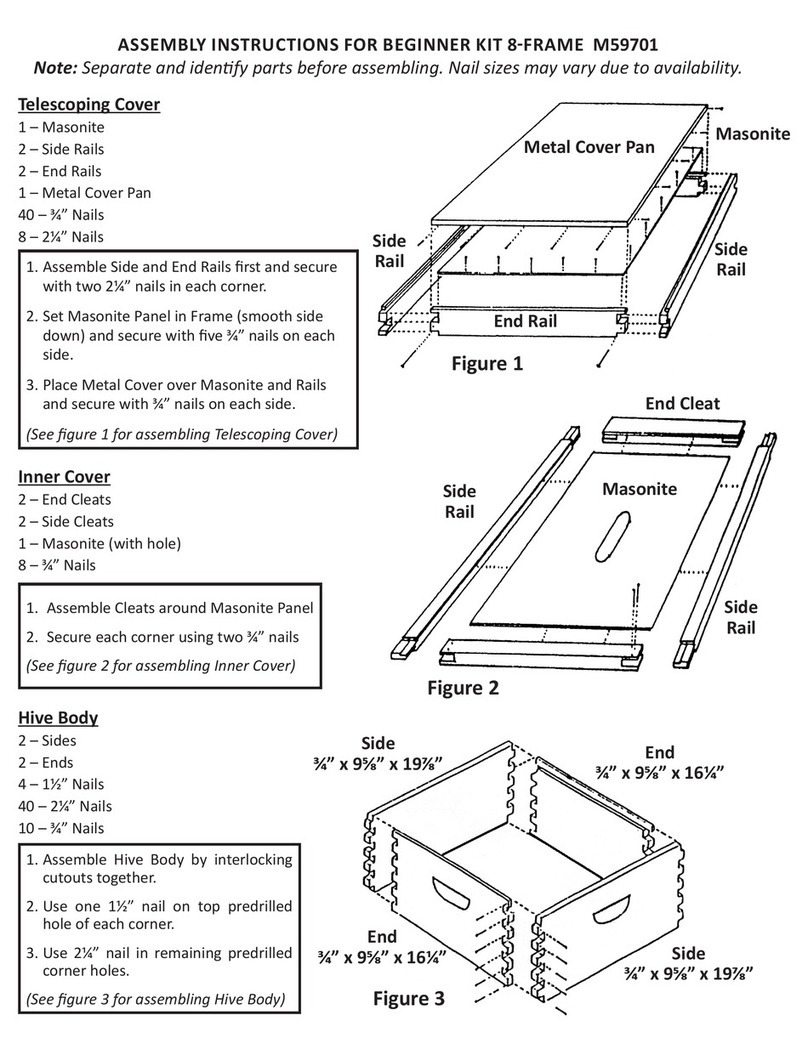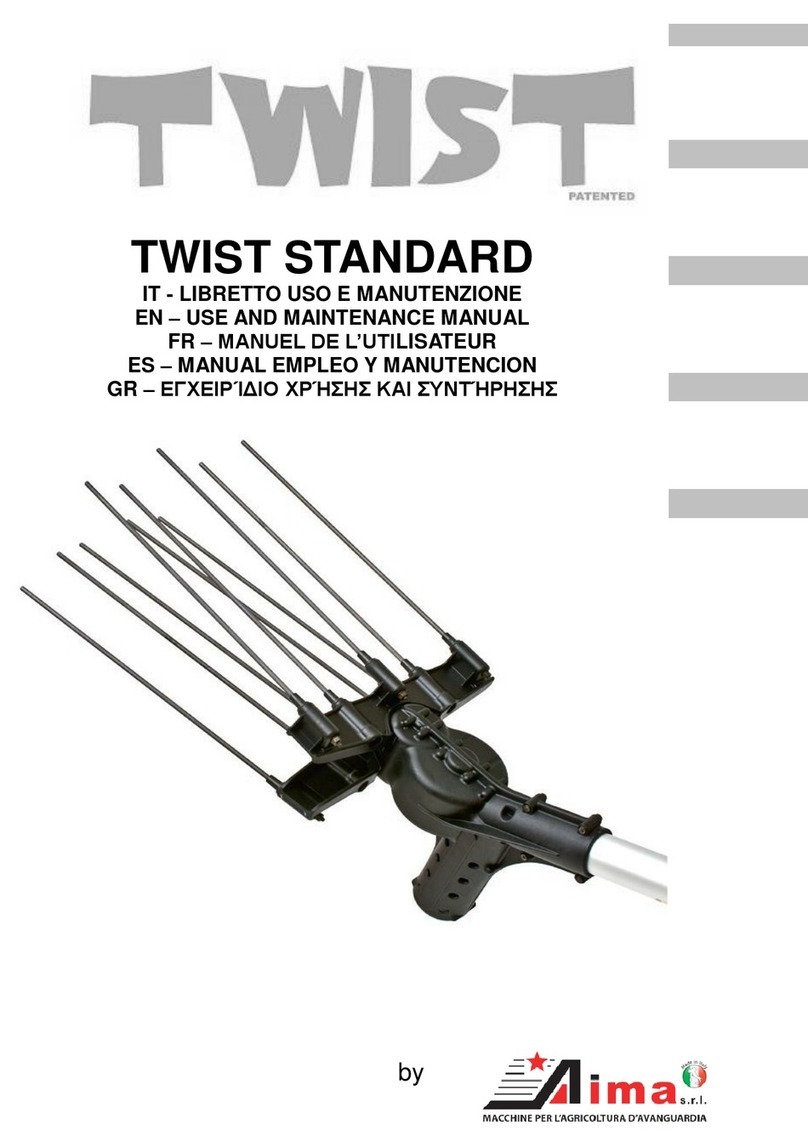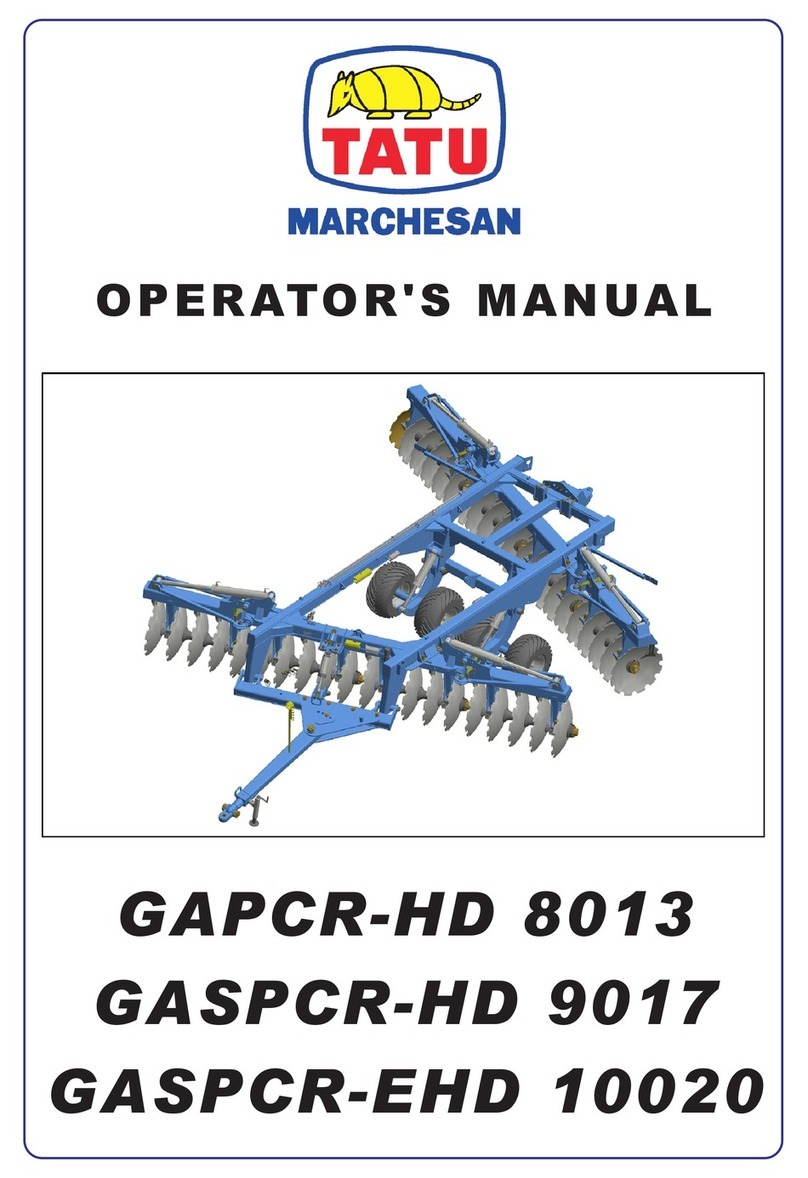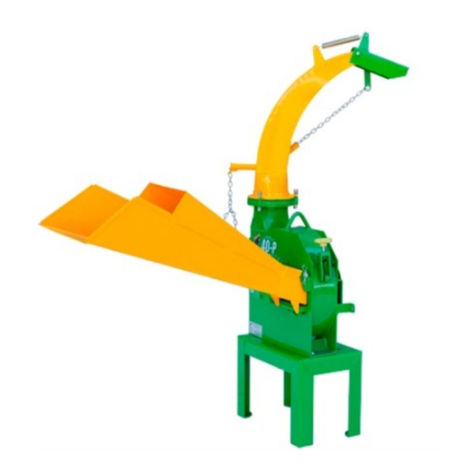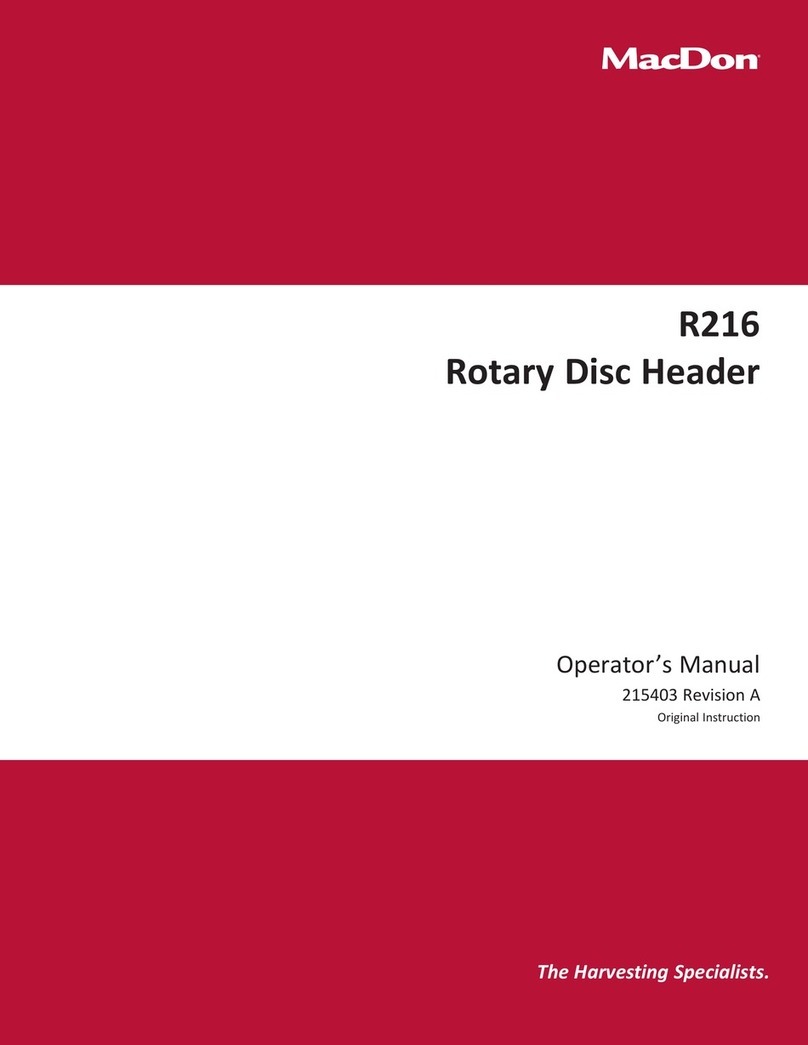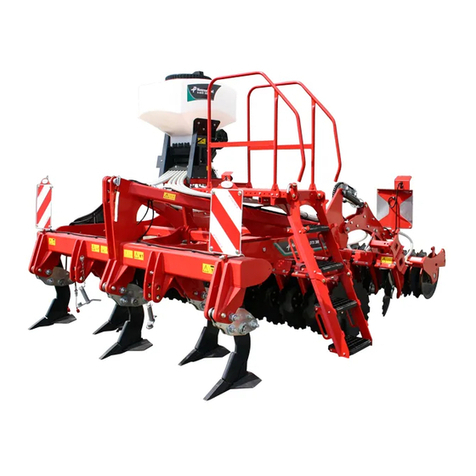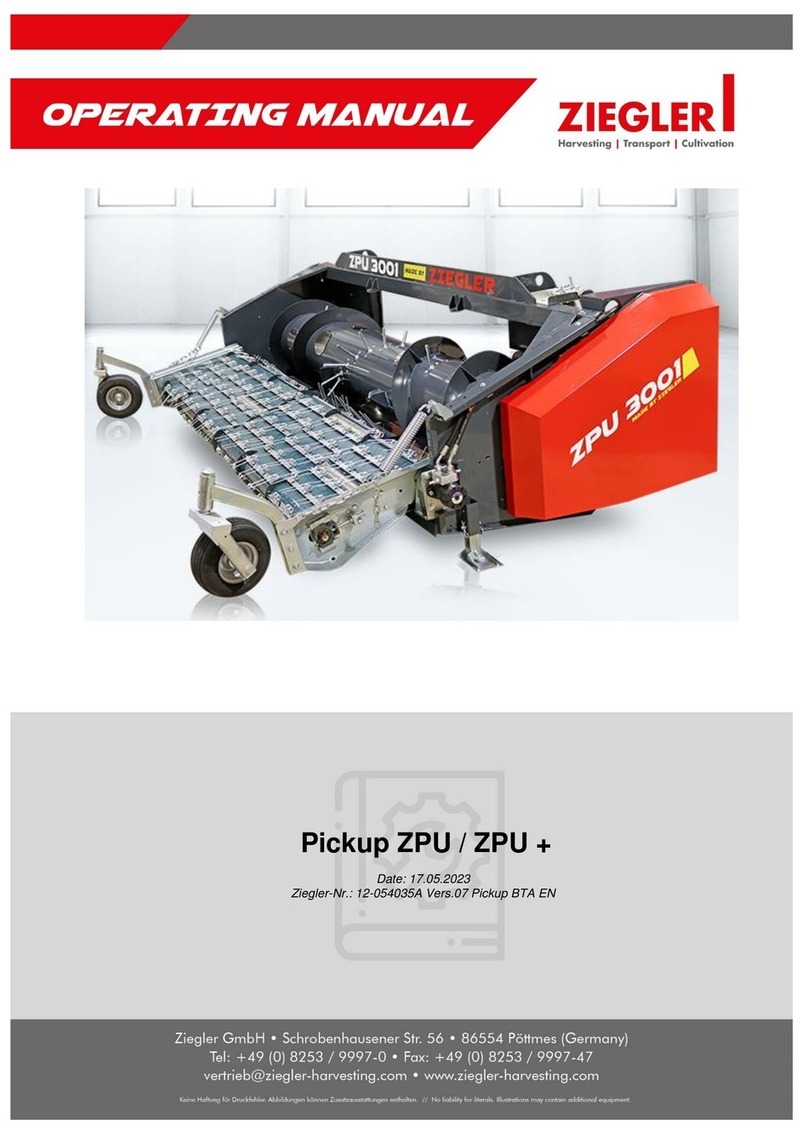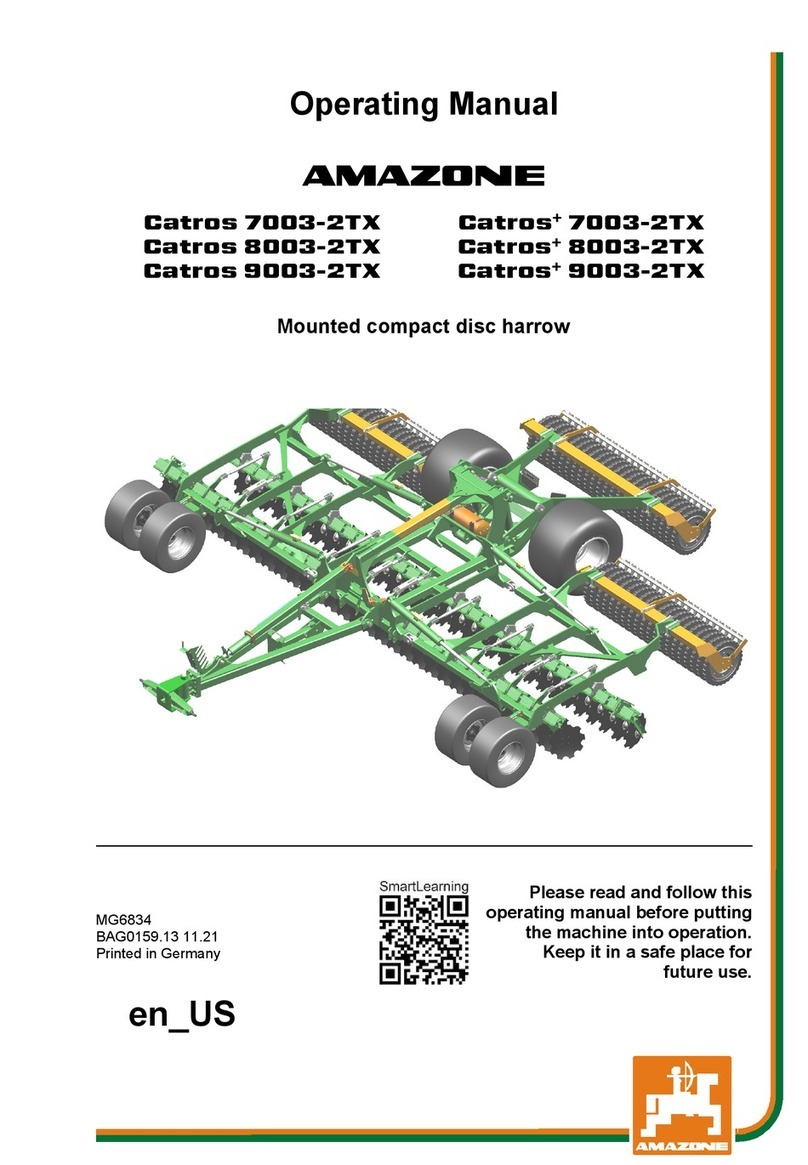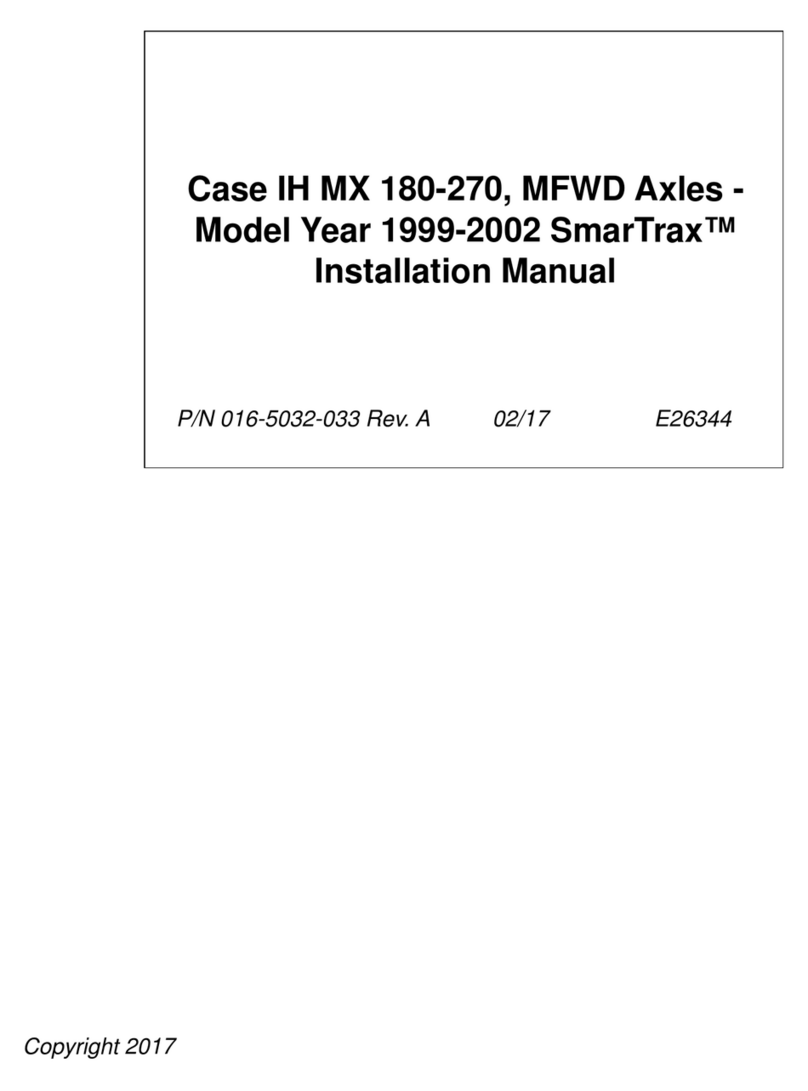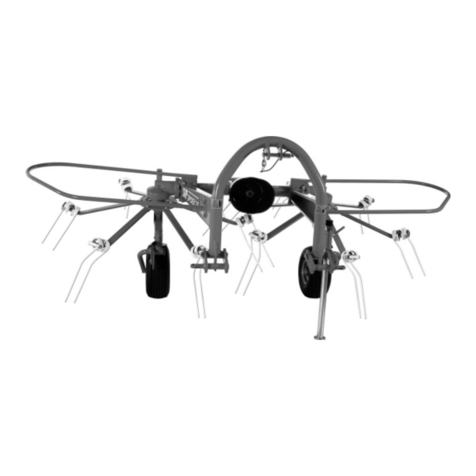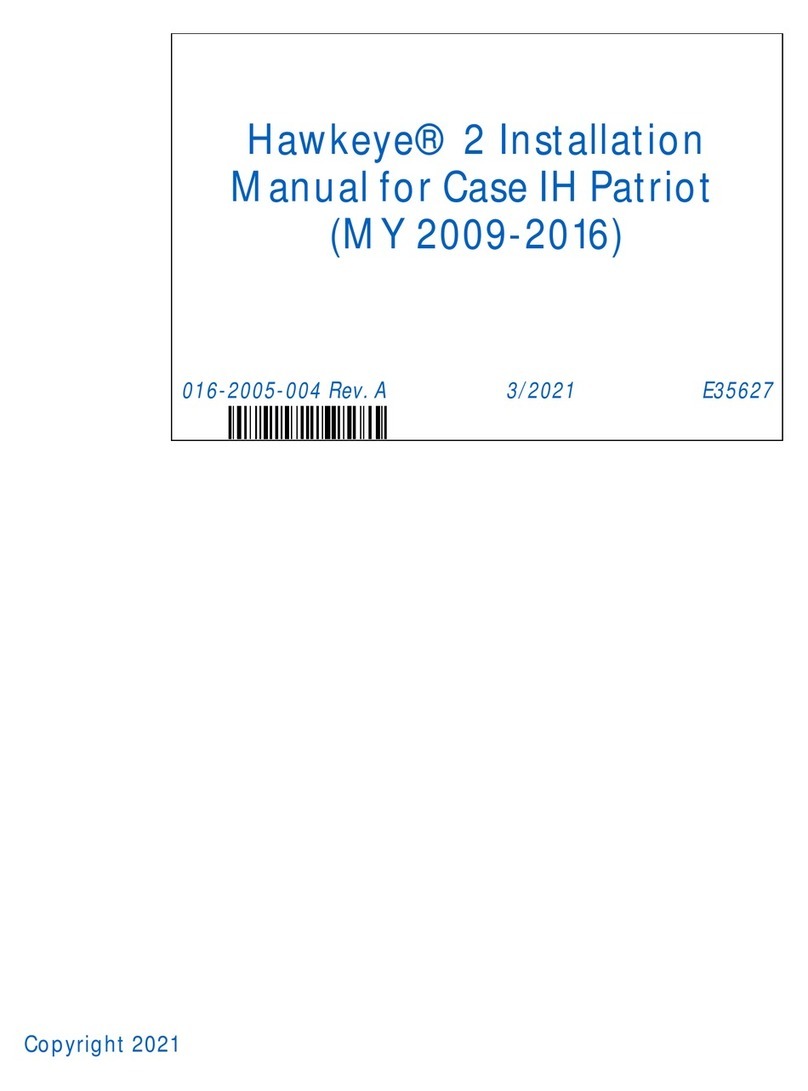Clipper PRELUDE 526 User manual

TABLE OF CONTENTS
WARRANTY .........................................................................
SPECIFICATIONS ...................................................................
SECTION I
Introduction.................................................................
Location......................................................................
Air Discharge..............................................................
Field Wiring................................................................
SECTION II
How to Change Eccentric Shaft...................................
Parts Lists....................................................................
SECTION III
Choosing the Right Screens..........................................
Placing Screens in Cleaner...........................................
Product Discharge........................................................
Trial Run......................................................................
General Maintenance...................................................

MACHINE SPECIFICATIONS
PRELUDE GRAIN-SEED CLEANER WITH AIR
No. of Screens in Cleaner…........................................5
Screen Size.....................……………………………...54 X 26”
Extreme Height.....................….............................…..91-1/4"
Extreme Length......................….................................99"
Extreme Width..........................…........................…..78-1/8."
Length on Floor..........................….......................…..73-3/8"
Width on Floor..............................….....................…..69-1/2"
Height Where Seed Enters.........................................67"
CFM Requirements - 1900 RPM (TOP FAN)............6000
CFM Requirements - 1600 RPM (TOP FAN)............4300
CFM Requirements - 1200 RPM (TOP FAN)…........2800
Shipping Weight ………………….....................…...…3800
Approximate Capacities (Bu. Per Hr.)*
A. Seeds & Grass....................................100
B. Seed Grain..........................................175
C. Beans & Wheat...............................….300
D. Scalping …………….……………….. .600
Horse Power Requirements:
A. Main Fan..................….10 Hp, 3 Phase, 230/460 Volt, 60 Hz, 1800 RPM
A. Main Fan..................….10 Hp, 1 Phase, 230 Volt, 60 Hz, 1800 RPM
A. Main Fan..................….10 Hp, 3 Phase, 200/380 Volt, 50 Hz, 1500 RPM
B Electronic Mechanical ..1/2 Hp, 180 Volt, Dc
Vibratory Hopper (1 Phase, 220 Volt, 60 Hz, Input)
B Electronic Mechanical ..1/2 Hp, 230 Volt, Ac
Vibratory Hopper (3 Phase, 230 Volt, 60 Hz, Input)
C. Eccentric ………....…..2 HP, 3 Phase, 230/460 Volt, 60 Hz, 1800 RPM
C. Eccentric ………....…..2 HP, 3 Phase, 200/380 Volt, 50 Hz, 1500 RPM
C. Eccentric ………....…..2 HP, 1 Phase, 230 Volt, 60 Hz, 1800 RPM
* All Capacities will vary depending on variety of grains/seeds cleaned, amount of foreign
material removal and moisture content.

INTRODUCTION
We cannot possibly answer all questions about the operation of CLIPPER CLEANERS in
this manual. We will try to give you basic information on the installation of your cleaner,
various adjustments for greater efficiency and a list of screen suggestions for top
performance from your cleaner.
There is nothing complex about the operation of a good seed or grain cleaner. The
operator has to familiarize himself with the machine and take time to study the shapes and
characteristics of the different commodities to be cleaned.
A commodity is cleaned to separate the good, marketable product from all impurities.
From a mechanical point of view poor cleaning is in most cases, caused by lack of proper
screens, improper use of screens or faulty regulation of the cleaner.
Perforations in the top screen should be just large enough to let the commodity being
cleaned fall through readily and small enough to scalp off foreign material such as sticks,
stems, chaff and larger seeds, or grain other than the product being cleaned. For most
commodities a round hole top screen is recommended.
After the round hole top screen has removed the objectionable foreign material larger than
the commodity being cleaned, the perforations of the lower two screens go to work. The
bottom screens remove foreign material smaller than the product being cleaned. Any
immature kernels, sand, dirt, or small weed seeds drop through the bottom two screen and
the good commodity passes over the bottom two screens. For most commodities, an
oblong sifting bottom screen is recommended.
Multiple screen cleaners permit normal top and bottom separations, plus additional
separations by shape. Screen recommendations for cleaning grain and seed are furnished
with this manual.
The purpose of air separations is to remove all possible light material without waste of
good grain or seed, and to control dust. Detailed instructions for regulating and controlling
the air separations are given in this manual.

LOCATION
Careful consideration must be given to selecting the proper location for the cleaner or the
best results in efficiency and convenience cannot be expected. All models should be
fastened to a solid, level floor or foundation. THE ENTIRE BASE OF THE MACHINE
SHOULD BE SUPPORTED. 3/4-8 grade 5 bolts are recommended. If an exiting
machine is being replaced, in almost all cases the exiting mounting stand will not be
built heavy enough to support the new machine being installed.
The cleaner should be placed with the fan discharge opening facing, and a short distance
away from an outside wall. Screens are inserted and withdrawn at the front of the cleaner.
Allow clearance for the operator to make screen changes. The largest single piece screen
is 54" x 26 ". Allow room around the cleaner for the operator to make adjustments and
service the machine. Do not install spouting in a position that will interfere with the controls
or maintenance. Eventually worn parts must be replaced so allow room to pull all shafts
and spouts.
The cleaned grain discharges from the under side of the cleaner, so it should be placed on
a floor with a pit or basement underneath so that an elevator with its receiving spout three
or four feet below the floor can be used to raise the grain. If the elevator cannot be carried
below the floor, and there is sufficient headroom, the cleaner may be placed on a solid
platform high enough above the floor to allow the grain to flow into the elevator or sacking
spout. Screenings and air lifting’s discharge from built-in spouts in the cleaner. Provision
must be made to handle this material.
The Cleaner hopper is a feeder mechanism - not a storage bin. Cleaners work best when
equipped with a surge bin above the hopper to provide a steady supply of the commodity
to the hopper. The grain supply to the surge hopper may be by spout from bins located on
the floor above or by means of an elevator from a sink of dump hopper on the same level
or lower than the cleaner. Spouts must have a fall of at least seven feet in ten to provide
free flow and should be carried directly at an angle instead of making right angle jogs. The
feed hopper works best when it is feed across the width of the hopper inlet opening.
If a full width feed cannot be used, a inverted y transition with a 24” distance
between the spouts is the second best style. This would drop the product to each
side of the hopper

AIR DISCHARGE
Improper air trunking installation from the cleaner and into the collector causes up to 90%
of the difficulties in conjunction with improper air movement. Sharp turns, improper
junctions, poor connections and poor collection equipment will all contribute to air
deficiency in a cleaner. Improper air clearance also results in a very dirty, dusty plant
operation. The Prelude back fan develops sufficient velocity so that cyclone-type collectors
or dust houses can be used to settle the dust and chaff from the air discharge of the
cleaner. The following are a few of the common errors found in plants and how each can
be avoided or corrected.
Refrain from installing elbows which have a sharp change of direction. Backpressures are
created at such points. In most cases, light chaff will be dropped into the pipe and finally
plug the entire run. A rule of thumb used at our plant is that the inside radius of the elbow
would be at least two and one half times the recommended diameter of the air pipe.
CFM Requirements - 1900 RPM................................6000 18” Diameter Pipe
CFM Requirements - 1600 RPM................................4300 17” Diameter Pipe
CFM Requirements - 1200 RPM................................2800 14” Diameter Pipe
The final source of trouble is the cyclone itself. If it is either too large or too small, or isn't
designed properly, or has a cap over the pipe discharging from the top of it, or in some
other way causes back pressure or pressure drop, or turbulence that interferes with the
cocooning action of the air inside the collector, the cleaner air system or the collector
system may not function properly.

DUST COLLECTOR
INFORMATION TO AID IN SPECIFYING
THE AIR ROTATION DIRECTION IS SPECIFIED, AS VIEWED LOOKING DOWN FROM
ABOVE.
COLLECTOR:
CLOCKWISE (ROTATION) COUNTER CLOCKWISE
(ROTATION)
Figure "A" Figure "B"
NOTE: Order using terms - clockwise and counter clockwise - only.
When planning an installation:
1. Avoid sharp bends and compound curves as they reduce the velocity and
encourage backpressure.
2. Install the cyclone as near to the cleaner as possible to eliminate length of air
travel and extra cost for excess ducting.
Figure "C" Figure "D"
(Correct) (Incorrect)
DO NOT CHANGE DIRECTION OF AIR TRAVEL.

FIELD WIRING INSTRUCTIONS
GENERAL
Cleaner drives and variable controls are available for NEC Class II, Division I, Group G or
Class II, Division II, Group G applications. For additional drive installation instructions, see
the manual section for field wiring.
NEC CLASS II, DIVISION II, GROUP G INSTALLATION
The motors and drive controls supplied with the cleaner meet the requirements of the
National Cod for this type of installation. The customer power and field wiring requirements
are shown on the wiring drawing. All field wiring and electrical components must adhere to
the NEC and/or local electrical code requirements, and are not the responsibility of the
manufacturer.
The following instructions apply to CLIPPER Conquest cleaner installations where National
Electric Code requirements of Class II, Division II, Group G (TEFC motors, NEMA 4
enclosures) apply.
The cleaners with their respective motors, motor controllers and operator variable control
panels have been factory tested and adjusted. No further adjustment of the DC motor
controller should be required at the installation site. The installer should refer to wiring
drawing (TEFC) for wiring (shown in dashed lines) and power requirements (disconnects,
motor starter/relay. All field wiring and electrical components must adhere to the NEC
and/or local electrical code requirements, and are not the responsibility of A. T. Ferrell
Company hereafter referred to as the manufacturer.
All control line wiring should be run in separate conduit
Low voltage wiring between DC or AC motor controllers, operator stations or RPM
pickup leads must not be combined with high voltage power wiring in common
conduits. Movement of factory installed electrical components can affect warranty.

CLEANER DRIVES 60 HZ THREE PHASE
Main Fan Motor 60 Hz
The main fan drive consists of a 10 HP, 1800 RPM, 230/460 Volt, 3 Phase, 60 Hertz,
TEFC motor and drive. Wiring and motor controls are not supplied by A. T. Ferrell
Company (See wiring drawing)
Fixed Speed Eccentric Drive
The eccentric drive consists of a 2 HP, 1800 RPM, 230/460 Volt, 3 Phase, 60 Hz, T E F C
motor and drive . Wiring is not supplied by A. T. Ferrell Company (see wiring drawing).
CLEANER DRIVES 60 HZ SINGLE PHASE
Main Fan Motor 60 Hz
The main fan drive consists of a 10 HP, 1800 RPM, 230 Volt, 1 Phase, 60 Hertz, TEFC
motor and drive. Wiring and motor controls are not supplied by A. T. Ferrell Company
(See wiring drawing)
Fixed Speed Eccentric Drive
The eccentric drive consists of a 2 HP, 1800 RPM, 230 Volt, 1 Phase, 60 Hz, T E F C
motor and drive . Wiring is not supplied by A. T. Ferrell Company (see wiring drawing).
CLEANER DRIVES 50 Hz
Main Fan Motor 50 Hz
The main fan drive consists of a 10 HP, 1500 RPM, 200/380 Volt, 3 Phase, 50 Hertz,
TEFC motor and drive. Wiring and motor controls are not supplied by A. T. Ferrell
Company (See wiring drawing)
Fixed Speed Eccentric Drive
The eccentric drive consists of a 2 HP, 1500 RPM, 200/380 Volt, 3 Phase, 50 Hz, T E F C
motor and drive . Wiring is not supplied by A. T. Ferrell Company (see wiring drawing).

SECTION II
HOW TO CHANGE ECCENTRIC SHAFT AND OR ECCENTRIC ASSEMBLIES
1. Record location of all parts including shaft and eccentric assemblies.
NOTE-------------------------------------------------------------------------------------------------
NOTE-------------------------------------------------------------------------------------------------
NOTE-------------------------------------------------------------------------------------------------
2. Remove drive pulley and belt.
3. Remove bolts fastening pitman arm to shoes (RECORD LENGTH FIRST).
NOTE-------------------------------------------------------------------------------------------------
NOTE-------------------------------------------------------------------------------------------------
NOTE-------------------------------------------------------------------------------------------------
4. Unscrew pitman arms from eccentric assembly
5. Remove bolts from outer and center bearings. Loosen lock collars.
6. Shaft with attached bearings can be removed from either side.
7. Remove keys, file set screw burrs, and oil shaft lightly.
8. Assemble by reversing above steps.

SECTION III
CHOOSING THE RIGHT SCREEN
The top-scalping screen is ordinarily chosen with an opening large enough to quickly drop
through the good commodity and direct the "overs" or scalpings off the screen end. The
sifting or finishing screens are selected with an opening that is just small enough to hold up
the commodity and drop through the "fines".
When selecting screens for any kind of seed or grain, it is always necessary to take into
consideration the condition of the commodity and the foreign material (FM) mixed with it. It
is frequently necessary to use screens that will remove a small percentage of the good
commodity with the foreign material in order to make the end product marketable.
It is advisable to have an assortment of our hand testing screens. By testing a handful of
grain or seed before cleaning, you can determine in advance the exact perforation size of
mesh to use and what separation can be made with the screens, and also what will have to
be done by the air. You can also determine what benefit would be derived from
recirculating any part of the stock, which cannot be improved by any change in setting in
the original run.
If you do not have the proper screens to clean a particular lot, send us a six-ounce sample
and we will make a screen selection for you. Send your samples to: A T Ferrell Seed
Laboratory, 1440 South Adams Street, Bluffton, Indiana 467l4.
PLACING SCREENS IN CLEANER
When removing blanks and splitters for the first time it is advisable for
you to mark each part with the location of where the part came out of
the machine. For example “ top screen, back 9 “blank”
Screens may be withdrawn or replaced from the front of the cleaner by removing the top
shoe spout and releasing the screen hooks. The screens slide in the screenways and are
removed one section at a time. A screen puller is used to reach the inner screen sections.
A screen puller is used to reach the inner screen sections. Insert the flat tab of the screen
puller between the screen and the ball tray with the rod part of the puller sticking up. Turn
screen puller 90 degrees. This expands the gap between the screen and ball tray so that
the rod part of the puller and be inserted behind the screen cross stick. Once the rod has
been inserted behind the cross stick turn the puller back 90 degrees so the rod part of the
puller is facing up again and pull out screen. Screens should be cleaned before storing.
When placing screens, ball trays and blanks back into the machine after cleanup, its best
to start on the bottom set of screens in each shoe. When replacing the screen sections
slide each section into the screen way but do not slide completely into the screen way.
Leave the end of each section out slightly beyond the end of the screen way so that the
next section can be placed with the lip in the correct downward or overlapping position.
PLACING SCREENS IN CLEANER CONT.

After all of the screen sections and accessory pieces have been correctly positioned, slide
them back as far as possible against the screen stops and secure with the screen hooks.
The lips on all screens will always be facing down hill and should be lipped over the next
screen.
Then slid the ball trays into the ball tray rails below that screen set. This will keep the balls
in place in the ball trays. The ball trays containing five balls per compartment do not have
to be removed for screen changes on current model cleaners. The balls should be
checked periodically for wear. If the ball diameters are less than 1-5/16 inches, or have
lost some of their bounce they should be replaced.
PRODUCT DISCHARGES
Before operating this equipment be sure that all discharges are properly spouted so that all
material is efficiently transported from the machine.
The PRELUDE REFERENCE ILLUSTRATION shows each of the product discharges. The
discharges are as follows:
1. Scalping Discharges: There is one scalping discharge included (item 1) on the
shoe.
2. Siftings Discharges: There are two siftings discharges included (item 2 and 3) on
the shoe.
3. Air Discharges: There is one air setting calibrated gate control and two air bleeder
doors for each of the air separations aspirations (items 11 and 9 for front and items
12 and 10 for back). All air lifting’s trash discharges out of one spout (item 4) All air
discharges from one air duct located at the back of the machine (item 5).
4. Clean Grain Discharge: The good product is discharged through the bottom of the
machine (item 6).

TRIAL RUN
WARNING!
Do not attempt to install, connect power to operate or service this machine without
proper instruction and until you have been thoroughly trained in its use by your
employer.
THE FOLLOWING ARE GENERAL GUIDELINES ONLY. YOUR SETTINGS WILL
PROBABLY VARY FROM THESE
With the proper screens in place and a supply of commodity to be cleaned in the storage
bin hopper above the cleaner, you are now ready to make an initial run to get the correct
regulations of the feed, shoe shake and air separations.
Please refer to the REFERENCE ILLUSTRATION to reference the following numbers. With
the internal gate inside the inlet hopper closed (8) start the main fan (5) and eccentric (7),
drive. Open the false air valve doors (9 and 10) on the air trunk to a 6 inch wide opening.
Set both the front (11) and back (12) air valve controls in the center holes. The eccentric
(7) shaft speed is already set at the factory At eccentric speeds below 360 RPM screen
blinding (plugging) may occur due to the decrease in ball movement under the screen
decks. At eccentric speeds above 420 RPM ball transfer may occur due to the increase in
ball movement under the screen decks. NEVER RUN THE ECCENTRIC SHAFT
SPEED ABOVE 420 RPM
ITEM NUMBER 1 - MECHANICAL VIBRATORY INLET HOPPER - VARIABLE SPEED
Open the internal hopper gate. Start the hopper drive. Increase the hopper speed until
about 1/2 to 3/4 of the top screen in the top shoe is covered. If the hopper speed must be
increased to near its highest speed return this speed to half the maximum and open the
hopper gate by moving the outside handle a couple of holes. Variations to this will occur if
you are trying to run a close tolerance between seed size and hole size of screen.
ITEM NUMBER 1 - MECHANICAL VIBRATORY INLET HOPPER - FIXED
Open the hopper gate until 3/4 of the top screen is covered and the desired capacity is
achieved. Variations to this will occur if you are trying to run a close tolerance between
seed size and hole size of screen.

AIR SETTINGS
Take a sample of the product coming out of the settling chamber discharge (Item 4).
The front air is set properly when a very small amount of good-looking seed is present in
this discharge. This seed usually will be the lightest of the good seed. If there is an excess
amount of good seed, close the front (11) air valve at the hopper end of the machine until
there are only a few good seeds in the settling chamber discharge. Please wait 10 seconds
for the adjusted setting to be discharged out the discharge (Item 4). If there are no good
looking seeds in the discharge, open the front (11) air valve until a small amount of good
seed appears in the settling chamber discharge. If you can’t pull good seed out of the
discharge close the front (9) false air valve door or doors to 4 inches and repeat above
procedure. Repeat this procedure for the back (12) settling chamber except you will be
working with the backset of doors (Item 10) and value (Item 12). After setting the back air
some small adjustment may be required to the front valve to get optimum performance.
The goal is to have the side (9 & 10) false air valve doors opened as wide as possible to
keep the front (11) air and the back (12) air from affecting each other when adjustment is
required. When the feed rate from the inlet hopper(8) is increased or decreased the air
must be readjusted.
GENERAL MAINTENANCE
Be sure all shaft and eccentric bearings are properly lubricated with a good grade of
pressure grease . For cleaners operating in extreme seasonal ambient temperatures the
type of grease used should take into account the seasonal temperature changes. The
cleaner should be lubricated at regular intervals depending on the location of the bearing.
Eccentric shaft and top fan shaft bearings
Bearings should be lubricated after every 250 hours of operation. One or two pumps on a
standard hand pump grease gun is sufficient. High pressure air operated grease guns
are not recommended
DATES:----------------------------------------------------------------------------------------------------------
-----------------------------------------------------------------------------------------------------------------
------------------------------------------------------------------------------------------------------------
Motor shaft bearings

Bearings should be lubricated once every year of operation. One pump on a standard
hand pump grease gun is sufficient. High pressure air operated grease guns are not
recommended
DATES:----------------------------------------------------------------------------------------------------------
-----------------------------------------------------------------------------------------------------------------
------------------------------------------------------------------------------------------------------------
Hopper drive shaft
Bearings should be lubricated after every 100 hours of operation. One pump on a
standard hand pump grease gun is sufficient. High pressure air operated grease guns
are not recommended
DATES:----------------------------------------------------------------------------------------------------------
-----------------------------------------------------------------------------------------------------------------
------------------------------------------------------------------------------------------------------------
WARNING!
Periodic attention MUST BE GIVEN to tighten all bolts and screws. Check weekly
for the first few months of operation. DO NOT OVER-TIGHTEN.
WARNING!
Do not attempt to work on, clean or service this equipment or open or remove any
protective cover, guard, grate or maintenance panel until the power has been turned
off and locked out and the machine has come to a complete stop.

ITEM NUMBER 1 - ROLL FEED INLET HOPPER - VARIABLE SPEED
Start the hopper drive. Open the hopper gate to 4 on the hopper gate control. Increase the
hopper speed until about 1/2 to 3/4 of the top screen in the top shoe is covered. If the
hopper speed must be increased to near its highest speed return this speed to half the
maximum and open the hopper gate a couple of turns. Variations to this will occur if you
are trying to run a close tolerance between seed size and hole size of screen.
ITEM NUMBER 1 - ROLL FEED INLET HOPPER - FIXED SPEED
Start the hopper drive. Open the hopper gate until 1/2 to 3/4 of the top screen is covered.
Variations to this will occur if you are trying to run a close tolerance between seed size and
hole size of screen.
Table of contents

